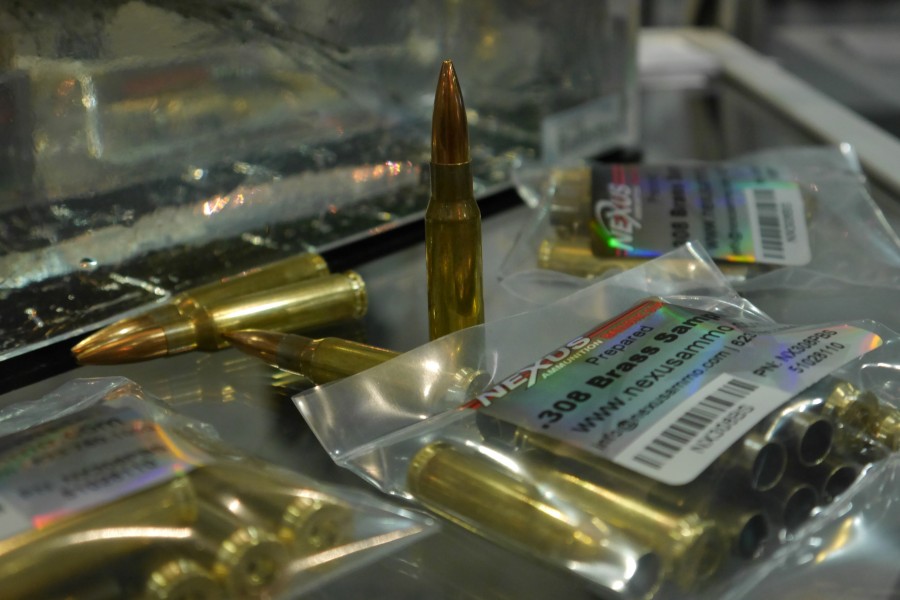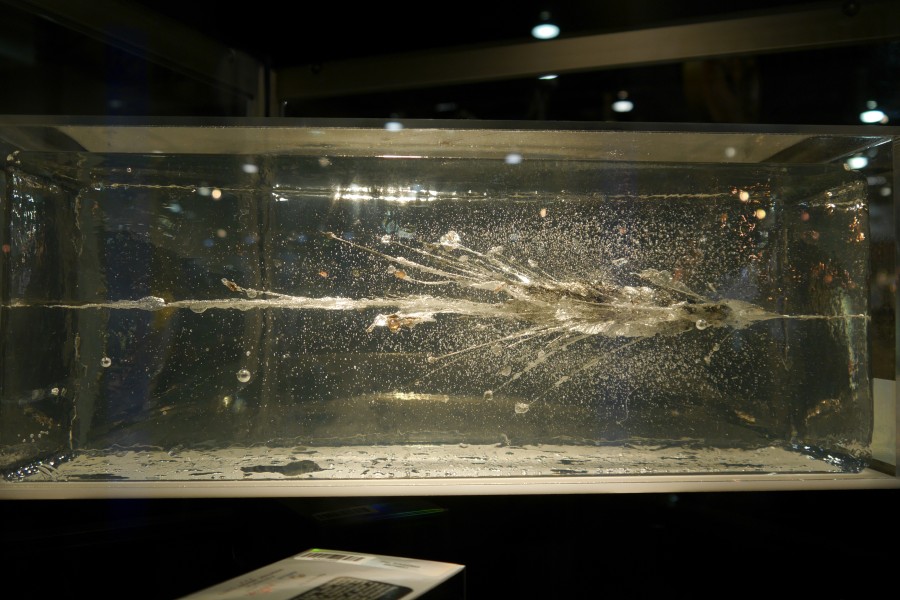Solid lead bullets have been the gold standard for ammunition for centuries. The dense metal is perfect for transferring force over great distances. But there are problems. Molten lead is hard to make into a homogeneous mass, and often there are air pockets or other impurities that keep the bullet from performing as expected. Nexus Ammunition is a company within the SAC group that also owns Armalite and McMillian. They say they have a solution to that age old problem: compressed metal . . .
Rather than using molten metal, Nexus Ammo starts with powdered compounds and compresses them into the proper shape. The primary benefit of the process is that there are no air pockets within the projectile and as such will allow it to stabilize in flight much butter. But there are some other major benefits as well. Due to the materials being used, the projectiles can be made lead-free without sacrificing anything in the process. There’s a bigger benefit, though.
The compressed metal process means that Nexus can use a blend of metals with different densities and properties, and tailor the terminal effects to meet the customer’s specifications. I talked with one of the guys from Nexus who explained how they were able to vary the density of the projectile to get either shorter or longer penetration in a gel block with a round of the same external dimensions. What was really interesting was that lower velocity rounds tended to have shorter penetration, and lower velocity went further through the block.
That variable density is going to be put to the test later this year with some innovative projectiles that are about to be released. According to the Nexus guys, they will be releasing a subsonic 5.56 round that cycles the action of an AR-15 rifle as well as a subsonic .308 round that cycles the action of a AR-10. It’s an interesting claim, and as a guy with a few cans, I can’t wait to see if it actually works.






“lower velocity rounds tended to have shorter penetration, and lower velocity went further through the block”
Am I reading this wrong, or is this a contradictory statement?
Me three…
-.-
As a general rule, higher impact speed = less penetration due to the greater impact force causing more damage to the bullet.
Shoot the same brand 22 out of a rifle and pistol (if you can find any, that is). The pistol’s bullet, with quite a bit less velocity, will often have deeper penetration.
Brass Fetcher on youtube has some videos demonstrating this.
Agree with jdb. With hollow points, higher impact speed many times means that the bullet will expand sooner and therefore stop at a shorter distance. Depending on the round, slower impact speeds can cause the bullet to expand later or not at all, leading to the bullet making a tiny hole and passing straight through the target with little resistance.
Can bacon bullets be that far behind?
I want a bullet that expands into the shape of Texas on impact.
I think what Nick means is that normally, standard low velocity rounds penetrate less, but with these rounds, the exact opposite is true.
I got the impression he was saying low velocity rounds tend to penetrate less, but this company’s low velocity rounds surprised him by penetrating further.
What Nick meant was that the flux capacitance injection across the sinosoidal curve of positronic phase modes results in a second order differential application of the Fibonacci sequence of Lamarkian acquisition on most Venn diagramatic representaions. Nick knows this because he be real good with arithmetic.
“stabilize in flight much butter”
DUDE I WANT BUTTER BULLETS, oh you meant better. 😉
Will butter bullets stay together? What’s the penetration on a stack of flapjacks? Can we get a syrup round to go with it?
Butter? I like butter!
No, the cool thing is that they totally liquify, massively infusing the target pancake.
What of the butter bullets are bitter, will that affect the batter?
This is REALLY cool, but I couldn’t help but notice:
“The primary benefit of the process is that there are no air pockets within the projectile and as such will allow it to stabilize in flight much butter.”
“…in flight much butter.”
“…butter.”
Don’t keep us in suspense! Just how much butter will they stabilize? Enough for one sandwich? Two? And how long a flight does it take for them to stabilize that much butter? The public wants to know!
You know that “Big Butter Jesus” at the state fair. Yeah, that much!!
http://www.imdb.com/title/tt1349451/
Parkay.
🙂
Wow.
Much butter.
Very bullet.
So yum.
Mmmmmmm, butter
Butter is good and all, but I’m holding out for the mouth penetrating bacon bullets.
Bacon bullets, coming soon to an Islamic extremest near you!
lol
It does have precedent:
http://en.wikipedia.org/wiki/Indian_Rebellion_of_1857#Tallow_and_lard-greased_cartridges
Dear Mr. Leghorn,
Sadly, no one has yet invented a “what you really meant when you wrote” (WYRMWYW?) checker that gets your sentences and wording right for you. No matter how you are pressed for time, you can’t rely on your spell checker alone to catch all your errors. It’s really a stupid, simple routine that compares each word against a list of words. Anything not in the list is computed to be “misspelled” – even words that make no sense. Your spell checker – and even your grammar checker – can’t find the mistakes you made. You, or better yet, someone else, simply must read it again carefully, and critically to catch the kinds of mistakes you made in this article.
Yes, I hope this does sound like your middle school english teacher scolding you. The mistakes are that bad.
“You, or butter yet, someone else, simply must read it again carefully, and critically to catch the kinds of mistakes you made in this article.”
FIFY
“they will be releasing a subsonic 5.56 round ”
Huh? Wouldn’t you just be better off using an air rifle at that point?
“When you absolutely, positively must piss someone off without killing them.” 5.56 subsonic
So airsoft then? They make some sweet looking airsoft ARs that can cost more than the real deal.
That got me good! Best laugh of the day so far.
“What was really interesting was that lower velocity rounds tended to have shorter penetration, and lower velocity went further through the block.”
What?
Is it just me or are the articles becoming more and more poorly written regarding spelling, sentence structure, and coherence?
Come on guys…someone needs to be editing these things before they get posted. Even some basic proofreading would go a long long way.
Or, we could just shake our heads and say, “They must be having a REALLY good time at SHOT.”
Can they do like modern fireworks and make different spread patterns? Like smiley-faces?
I want mine to make eagles in whatever I shoot.
Most silencer manufacturers say frangible ammo is a no-no, so I’m not seeing any of these making their way into my ammo stash.
As these are jacketed, I don’t see how there would be a problem. You aren’t getting the powder build-up that you’d see with bare sintered or polymerized metals.
That’s odd, I didn’t know they were making jacketed bullets by pouring molten lead. I was under the impression that swaging was used.
What do you think the swag was made from? Something that was molten at some point, no doubt.
Projectiles made from sintered materials have patents stretching back to the early 90s that I remember. I’m sure they go back further.
I remember there was a lot of work in this field, after Mr. Gorbachev tore down that wall. Lots of unemployed brainiacs from the former Soviet military industrial complex were really bored. And desperate for new gigs doing what they were trained to do.
Fill the hollow point bullets with Bacon Grease!
Traditional trade is termed bespoken trade within the uk, wherever the center of the trade is London’s Savile Row trade, and custom trade within the u. s. and Hong Kong. this can be in contrast to created to live that uses pre-existing patterns. A bespoken garment or suit is totally original and distinctive to every client.”
Comments are closed.